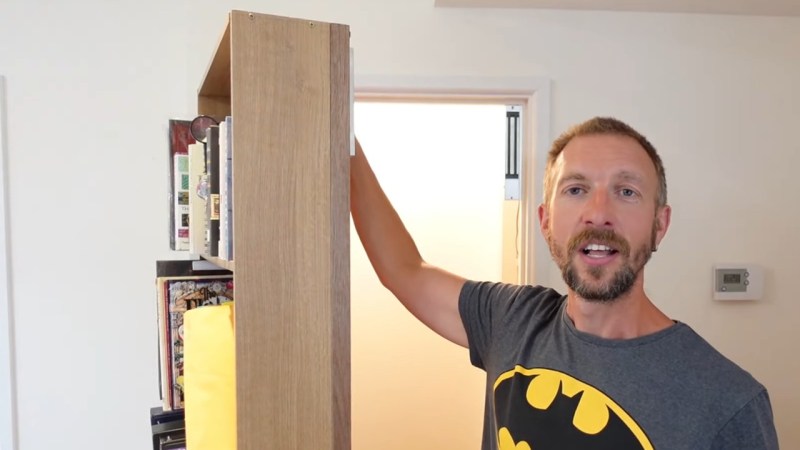No spooky mansion is complete without a secret passage accessed through a book shelf — or so Hollywood has taught us. What works as a cliché in movies works equally well in an escape room, and whenever there’s escape rooms paired with technology, [Alastair Aitchison] isn’t far. His latest creation: you guessed it, is a secret bookcase door.
For this tutorial, he took a regular book shelf and mounted it onto a wooden door, with the door itself functioning as the shelf’s back panel, and using the door hinges as primary moving mechanism. Knowing how heavy it would become once it’s filled with books, he added some caster wheels hidden in the bottom as support. As for the (un)locking mechanism, [Alastair] did consider a mechanical lock attached on the door’s back side, pulled by a wire attached to a book. But with safety as one of his main concerns, he wanted to keep the risk of anyone getting locked in without an emergency exit at a minimum. A fail-safe magnetic lock hooked up to an Arduino, along with a kill switch served as solution instead.
Since his main target is an escape room, using an Arduino allows also for a whole lot more variety of integrating the secret door into its puzzles, as well as ways to actually unlock it. How about by solving a Rubik’s Cube or with the right touch on a plasma globe?















You could do the same with multiple switches and an order for the books to be moved in to open the door
Or someone could use a logic circuit.
If one of the wrong switches is pressed, the power path will be disconnected or reset somehow.
A relays logic can help here. Especially self-holding relays could be used for implementing certain mechanisms/rules.
Relays can also help forming a route, an order, in which buttons or switches must be operated.
If someone triggers a “trap” the relays logic will rearrange, rewire, its own power path.
Don’t caster wheels leave tracks on the floor, ruining the while thing about the bookcase being a hidden exit?
I ask because I was curious about how he would solve that problem.
Of course, you can make the whole room dark so nobody would see the tracks. But if I were in that room and would be stuck, for sure I would think about feeling the floor for tracks or scratches.
That’s why, if I ever made a bookcase door, I would make it swing out, so the tracks would be in the hidden room.
Thumbs up!
Well, that and doorframe left in place around it…
This is why I stick to rotating fireplaces with perfectly circular hearth floors. The casters are hidden in the subfloor. Genius!
Put… the candle… back!
Reported my own comment. This is the second in a row that has incorrectly posted as a reply to another comment. I know for a fact that when I posted this comment, it was done with no other comment selected for reply.
Fix your stuff plz.
This comment is unmonitored, because of how WordPress implements such things. I can be reache, if need be, by email at the address in the form, or on the [dot]io side under the same username.
They might do after an extended period of usage, in the same way that any piece of floor that is routinely walked-on or has furniture moved across it will. But that’s only true if you have particularly soft wooden floorboards!
Didn’t watch the vid. How many fur suits does he have in his room of shame?
Hollywood? Those old London studio Sherlock Holmes movies.
Oh!
What is it!
A priest hole….
Hi. I’m wondering what is the maximum width of a hidden bookcase door so it won’t warp after a while?
I’ve seen that they can be quite wide: https://www.secretpassage.co.uk
I have an opening of 2 meters.